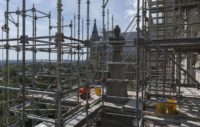ENR 2023 Top 25 Newsmakers
Theodora Diamantis: Played Key Role in Rebuilding Iconic Greek Orthodox Church Destroyed on Sept. 11

Diamantis was a critical decision-maker to bring Skanska USA Building back to the project after a three-year work stoppage. When the contractor halted construction on the $85-million church in 2017 after payment lapses, it was unclear when or how work would resume.
Photo courtesy Bernstein Associates

Related Article:
New York 2023 Project of the Year: Saint Nicholas Greek Orthodox Church
Back to:
25 Top Newsmakers
Four years after the team broke ground on the 12,000-sq-ft Saint Nicholas Greek Orthodox Church and National Shrine in lower Manhattan to replace its beloved predecessor destroyed in the Sept. 11, 2001 terrorist attacks, it was not clear if work would finish. Construction on the high-profile structure—designed by Santiago Calatrava Architects & Engineers and built as part of World Trade Center reconstruction—began in 2013, but significant design changes that inflated the original $20-million budget and church financial difficulties combined to derail the project. In 2017, after having topped out the steel frame structure, Skanska USA Building halted work after payment lapses, and the project fell into limbo—the frame left wrapped in white plastic. A committed effort by state officials, project team members, the Greek Orthodox Archdiocese of America and the newly formed Friends of Saint Nicholas organization found a path to resume work and reach completion in late 2022.
Restarting construction after a multiyear hiatus was a significant challenge, says Skanska Vice President and Account Manager Theodora Diamantis, who participated in discussions to resume work. But the result was an $85-million expertly crafted gem, with a structural steel dome topped by a thinly milled, translucent Pentelic marble exterior. The 60-ft-span dome’s signature rainscreen, with 40 skylights and strategic lighting, illuminates the church interiors by day and transforms the structure into a glowing landmark by night.
Diamantis, who was responsible for the project budget and schedule, was part of the Skanska team that reentered negotiations, developed contract terms and conditions and set schedule expectations that let the project restart and ensured its completion. “[We focused] on building a positive relationship with the new ownership group,” she says. “Establishing trust was crucial in ensuring that the new owners had confidence in Skanska’s ability to complete this high-profile project successfully.”

Theodora Diamantis
Photo courtesy of Skanska
Construction restart in July 2020 was hampered by COVID-19 restrictions, followed by supply chain woes. That heaped pressure on goals to meet important milestones, such as the church holding a ceremony to mark the 20th anniversary of the attacks. That led to Skanska’s decision to schedule 20-hour workdays, six days a week from June to September 2021, Diamantis says. Creative use of temporary materials and careful logistics management on a tight footprint within the high-security site work zone also were critical to meeting the goal. “The project faced extraordinary circumstances,” she says. “Recognition that it was not ordinary, with many activities being firsts for both Skanska and subcontractors, emphasized the need for innovation and problem-solving.”
Managing the supply chain crisis was another huge task, as the team applied great coordination and logistics management to craft and import prefabricated pieces, iconography and materials from nine countries and three continents on a tight schedule—including 10,000 sq ft of white marble from Athens. Watchful cost estimating and revisions, strategic schedule management and the careful selection of specialized subcontractors and materials suppliers also contributed to the project’s success, Diamantis says.
Diamantis’ team performed a “Herculean task” to turn Calatrava’s “breathtaking design … into a reality,” says Andrew Veniopoulos, St. Nicholas National Shrine executive director.
All ENR 2023 Top 25 Newsmakers will be honored at the Award of Excellence Gala on April 11 in New York City.




